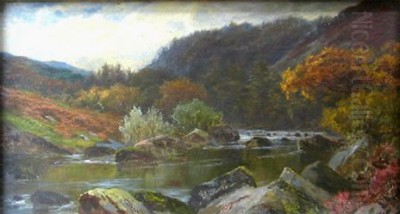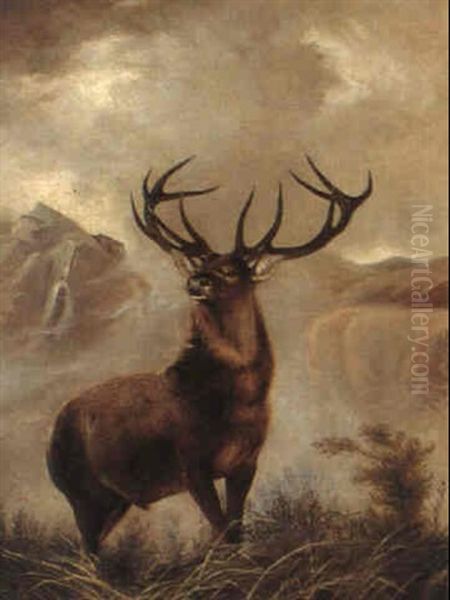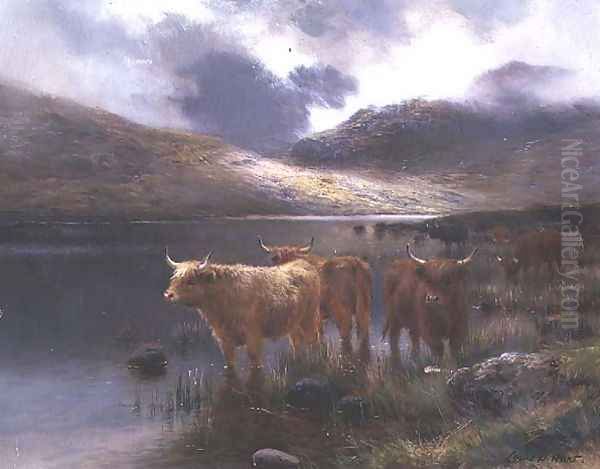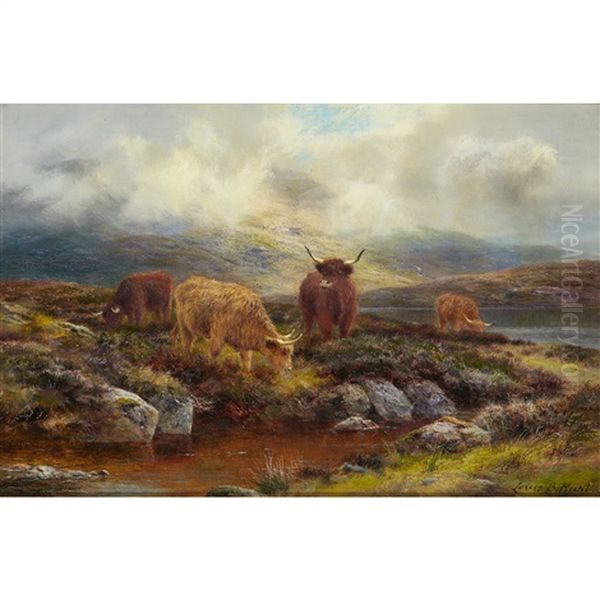
Louis Bosworth Hurt (1856-1929) stands as a significant figure in late Victorian and Edwardian British art, celebrated primarily for his evocative and atmospheric depictions of the Scottish Highlands and, most notably, its iconic Highland cattle. Working predominantly in oils, Hurt captured the wild beauty, dramatic weather, and rugged spirit of these northern landscapes, creating works that resonated deeply with the sensibilities of his time and continue to find favour with collectors today. His journey from a tailor's apprentice in Derbyshire to a respected exhibitor at the Royal Academy is a testament to his innate talent and dedication to his craft.
Early Life and Artistic Beginnings
Born in Ashbourne, a historic market town nestled within the picturesque landscape of Derbyshire, England, in 1856, Louis Bosworth Hurt's early life did not immediately suggest a future in the fine arts. He initially embarked on a practical career path, undertaking an apprenticeship as a tailor. However, the artistic impulse was strong, and Hurt began to cultivate his talent for drawing and painting during his leisure hours. His burgeoning skills did not go unnoticed.
Recognizing his potential, Hurt sought formal instruction. He found a mentor in the established Derbyshire landscape painter, George Turner (1841-1910). Turner, sometimes referred to as "Derbyshire's John Constable," was a respected artist known for his faithful and charming depictions of the Midlands countryside, particularly the area around Barrow upon Trent. Studying under Turner provided Hurt with a solid foundation in landscape painting techniques, including composition, colour theory, and the handling of oil paint. This early training grounded his work in the British landscape tradition.
Influences and Artistic Development
While George Turner provided foundational training, Hurt's mature style evolved under a broader range of influences. His development reflects the artistic currents of the late 19th century, particularly the enduring appeal of Romanticism blended with Victorian realism. Two artists are frequently cited as significant influences on Hurt's work, shaping his choice of subject matter and stylistic approach.

Sir Edwin Landseer (1802-1873), the pre-eminent animal painter of the Victorian era, undoubtedly left a mark. Landseer's dramatic and often anthropomorphized depictions of animals, especially deer and dogs within Scottish settings (like his famous Monarch of the Glen), set a high standard for animal portraiture. Hurt absorbed Landseer's skill in rendering animal anatomy and fur textures with convincing realism, though Hurt's own depictions of cattle tended to be less overtly sentimental, focusing more on the animals within their natural environment.
Perhaps even more pertinent was the influence of the Scottish painter Peter Graham RA (1836-1921). Graham specialized in dramatic Scottish Highland scenes, often featuring Highland cattle amidst mist-shrouded mountains or coastal settings. His work was immensely popular, and Hurt's paintings, particularly his focus on similar subjects and atmospheric effects, inevitably drew comparisons. While influenced by Graham, Hurt developed his own distinct interpretation, often imbuing his scenes with a unique sense of tranquility or rugged grandeur. It's also noted that Hurt may have been influenced by George Turner's son, William Lakin Turner (1867-1936), who continued his father's landscape tradition.
The Call of the Highlands
Although rooted in Derbyshire, Hurt's artistic imagination was increasingly captivated by the dramatic landscapes of Scotland. In the early 1880s, he made the decisive step to become a full-time professional artist, dedicating his focus primarily to Highland subjects. This was a period when the Scottish Highlands held a powerful allure for the British public, fueled by Queen Victoria's affection for Balmoral, the Romantic literature of Sir Walter Scott, and improved railway access making the region more accessible for tourism and artistic exploration.
Hurt tapped into this fascination, travelling to Scotland to sketch and gather material for his studio paintings. His works captured the essence of the Highlands – the vast, rolling moors, the imposing mountains often wreathed in mist, the turbulent burns (streams), and the ever-changing light and weather. He became particularly adept at rendering the damp, atmospheric conditions characteristic of the region, using subtle gradations of tone and colour to convey depth and mood.
His commitment to these subjects quickly brought him recognition. He began exhibiting his work widely, making his debut at the prestigious Royal Academy in London in 1882. In the same year, he also exhibited at the Birmingham Society of Artists. These exhibitions provided crucial exposure, bringing his work to the attention of critics, the public, and potential patrons. His success was relatively swift, indicating that his chosen subject matter and skilled execution struck a chord with contemporary tastes.
Signature Subject: Highland Cattle

While a capable landscape painter in his own right, Louis Bosworth Hurt is inextricably linked with his depictions of Highland cattle. These hardy, long-horned, shaggy-coated beasts became his trademark, featuring prominently in the majority of his best-known works. He portrayed them not merely as incidental elements in the landscape, but often as the central focus, capturing their distinct character and their harmonious existence within the wild terrain.
Hurt's approach to painting cattle combined anatomical accuracy with an appreciation for their rugged aesthetic. He observed them closely, understanding their posture, movement, and how their thick coats responded to different weather conditions – rain-slicked, catching the Highland mist, or lit by shafts of sunlight breaking through clouds. His paintings often depict small groups or solitary animals grazing on moorland, wading through shallow lochs, or navigating rocky paths, emphasizing their resilience and adaptation to the challenging environment.
His dedication to authenticity extended to his personal life. After his marriage, he and his wife reportedly kept a small herd of Highland cattle at their Derbyshire home. This allowed Hurt constant opportunities for close study, sketching the animals from life in various poses and conditions. This direct observation undoubtedly contributed to the convincing realism found in his paintings, setting his work apart from artists who might rely solely on secondary sources. While influenced by the animal painting tradition exemplified by Landseer and contemporaries like Briton Rivière (1840-1920), Hurt carved his own niche with his consistent focus on this specific breed within its native landscape. Some works are noted for a subtle humour or narrative element, but generally, the focus remained on naturalistic portrayal.
Landscapes of Scotland and Derbyshire
Beyond the cattle themselves, Hurt demonstrated considerable skill in rendering the landscapes they inhabited. His Scottish scenes often convey a powerful sense of place, capturing the scale and atmosphere of the Highlands. Titles of his works, such as Through Glencoe by Way to the Tay, A Spate on the Spean, and Stack-an-Arnim, St Kilda, indicate his travels and his interest in specific, often dramatic, locations known for their natural beauty. He excelled at painting water, whether the calm surface of a loch reflecting the sky or the rushing movement of a burn in spate (flood).

His handling of light and atmosphere was crucial to the success of his landscapes. He frequently employed soft, diffused light, typical of overcast or misty Highland days, creating a mood of quiet solitude or brooding majesty. However, he could also capture the fleeting moments of sunshine breaking through clouds, illuminating parts of the landscape and creating dramatic contrasts. His palette often favoured earthy tones – browns, ochres, greens, and greys – appropriate for the Highland terrain, but punctuated with touches of brighter colour where needed.
While best known for Scotland, Hurt did not entirely abandon his native Derbyshire. His love for his home county is also reflected in his art, though these works are less common than his Highland scenes. The softer, rolling landscapes of the Peak District offered a different kind of beauty, which he occasionally depicted, likely influenced by his early training with George Turner and potentially aware of the work of other Derbyshire artists like David Payne (1843-1894). However, it was the wilder, more romantic landscapes of the north that truly defined his artistic identity.
Life and Work: Derbyshire and Beyond
Louis Bosworth Hurt established his professional and personal life primarily in Derbyshire. In 1881, around the time he committed to painting full-time, he married Harriette Marion Bickley. The couple settled in the village of Ivonbrook, near South Darley and Matlock. Their home appears to have been a supportive environment for his art, particularly with the shared venture of keeping Highland cattle for study. Sources vary on the number of children they had, mentioning either two sons or three children in total.
His connection to Derbyshire remained strong throughout his life, providing a stable base from which he made his sketching trips north. However, his artistic explorations were not limited solely to Scotland. Evidence suggests he also developed connections with artists in North Wales and maintained a small cottage in the renowned artists' colony of Betws-y-Coed. This location, nestled in the Conwy Valley on the edge of Snowdonia National Park, was a magnet for landscape painters throughout the 19th century, attracted by its dramatic mountain scenery, wooded valleys, and picturesque river subjects. Hurt likely used this cottage as a base for sketching expeditions into Snowdonia, capturing its distinct mountainous beauty, perhaps offering a different but equally dramatic counterpoint to the Scottish Highlands.

His professional life centred around producing paintings for exhibition and sale. His success at major venues like the Royal Academy and the Royal Society of British Artists (RBA), along with regional exhibitions in places like Birmingham and Derby, ensured a steady demand for his work. He attracted a clientele of wealthy patrons and middle-class buyers who appreciated his skillful and evocative depictions of popular subjects. This commercial success allowed him to maintain his professional career over several decades.
Exhibitions, Recognition, and Friendships
From his debut in 1882, Hurt became a regular exhibitor at key London and regional venues. Consistent presence at the Royal Academy exhibitions was particularly important for establishing and maintaining an artist's reputation during this period. His works were generally well-received, appealing to the public taste for skillfully executed, recognisable, and often sentimentally appealing landscape and animal subjects. He exhibited alongside many prominent artists of the day, contributing to the vibrant Victorian and Edwardian art scene.
His work found its way into numerous private collections across Britain. He also gained recognition from fellow artists and prominent figures in the art world. A notable testament to this comes from Sir Merton Russell-Cotes (1835-1921), a hotelier, politician, and avid art collector who established the Russell-Cotes Art Gallery & Museum in Bournemouth. In his autobiography, Sir Merton referred to Louis Bosworth Hurt as one of his "most intimate friends" and praised him highly, calling him "the most conscientious man amongst all my artist friends." This personal endorsement from a major collector highlights the respect Hurt commanded. The Russell-Cotes Art Gallery & Museum today holds several of Hurt's works, preserving examples of his output for public view. Other institutions, like the Derby Art Gallery, also hold examples of his paintings, reflecting his regional importance.
The popularity of his work extended beyond England, naturally finding favour with Scottish art enthusiasts and collectors who appreciated his faithful depictions of their national landscapes and iconic cattle. His success can be seen in the context of other popular landscape and animal painters of the era, such as Benjamin Williams Leader (1831-1923), known for his Worcestershire landscapes, Alfred de Bréanski Sr. (1852-1928), another painter of Scottish and Welsh scenes, and Joseph Farquharson (1846-1935), famed for his snow scenes often featuring sheep. Hurt held his own within this competitive field through his specialized focus and consistent quality.
Artistic Style and Technique
Louis Bosworth Hurt's style is best characterized as a blend of Romanticism and Realism, typical of much mainstream British landscape painting in the late 19th century. The Romantic element is evident in his choice of subject matter – the wild, untamed beauty of the Highlands – and his emphasis on atmosphere and mood. He aimed to evoke an emotional response in the viewer, conveying the grandeur, solitude, or sometimes the harshness of nature.
The Realist aspect lies in his careful observation and detailed rendering, particularly of the Highland cattle and the specific features of the landscape. His training under George Turner likely instilled a respect for accurate depiction. He paid close attention to texture – the shaggy coats of the cattle, the rough surfaces of rocks, the dampness of vegetation after rain. His compositions are generally well-structured, often using traditional landscape conventions like foreground interest leading the eye into the scene, but always serving to highlight the natural beauty of the subject.
Working primarily in oils on canvas, Hurt demonstrated a confident handling of the medium. His brushwork could vary from relatively tight and detailed in the rendering of the cattle to broader and more suggestive strokes in the background landscapes and skies, effectively creating a sense of depth and atmosphere. His use of colour was generally naturalistic, reflecting the often-muted tones of the Highland environment, but he skillfully employed variations in light and shadow to create focal points and enhance the dramatic or tranquil mood of the scene. Works like A Passing Shower would have showcased his ability to capture transient weather effects.
Representative Works
Several paintings stand out as representative of Louis Bosworth Hurt's oeuvre, showcasing his typical subjects and stylistic strengths:
Highland Cattle Crossing a Scottish Moorland: This title, or variations thereof, represents a quintessential Hurt subject. Such works typically depict a group of Highland cattle moving through a vast, open moorland landscape, often under an atmospheric sky, emphasizing the harmony between the animals and their environment. These remain among his most sought-after paintings.
Caledonia, Stern and Wild (1907): The title, likely referencing Sir Walter Scott, immediately evokes the romantic image of Scotland. This painting is considered one of his most successful and popular works, presumably capturing a particularly dramatic or evocative Highland scene featuring his signature cattle.
Study of a Highland Cow: Works with this title suggest smaller, more focused studies, perhaps preparatory sketches for larger compositions or intimate portraits of individual animals. They highlight his skill in detailed animal depiction.
Through Glencoe by Way to the Tay (1899): This title points to a specific journey or location, suggesting a grander landscape composition potentially incorporating the dramatic scenery of Glencoe and the River Tay region, with cattle likely featuring prominently.
A Spate on the Spean: This work would depict the River Spean in flood, offering Hurt an opportunity to paint the dynamic movement of water alongside his usual Highland cattle and landscape elements, likely conveying the power of nature.
Stack-an-Arnim, St Kilda: Depicting a scene from the remote St Kilda archipelago suggests Hurt travelled quite widely in search of dramatic subjects. This painting would likely feature rugged coastal scenery, sea stacks, and perhaps seabirds alongside or instead of cattle.
A Passing Shower: This title indicates a focus on capturing a specific, transient weather effect – a common theme in British landscape painting. It would showcase his ability to render rain, clouds, and changing light conditions within a Highland setting.
The Sound of Bressay, Shetland: Similar to the St Kilda painting, this work places Hurt in the Shetland Islands, depicting the channel between Bressay and the Shetland mainland. It likely features coastal scenery and perhaps reflects the unique light and atmosphere of these northern isles.
These titles collectively illustrate the range of Hurt's focus within his chosen specialization: Highland cattle, specific Scottish locations, dramatic landscapes, and atmospheric weather conditions.
Legacy and Historical Evaluation
Louis Bosworth Hurt died in 1929, leaving behind a substantial body of work that continues to be appreciated for its technical skill and evocative portrayal of a specific aspect of British landscape and animal life. He is firmly placed within the tradition of late Victorian and Edwardian representational painting, catering to the tastes of his time but doing so with genuine affection for his subjects and considerable artistic ability.
While perhaps not considered an innovator who radically changed the course of art history, Hurt achieved significant success and recognition within his field. He mastered a popular genre, becoming one of the foremost painters of Highland cattle, a subject he made distinctively his own. His work is valued for its consistent quality, atmospheric beauty, and faithful depiction of the Scottish Highlands.
His paintings remain popular in the art market, frequently appearing at auction and often commanding respectable prices, particularly for large, well-executed examples of his classic Highland cattle scenes. This enduring market appeal testifies to the lasting visual charm of his work. He is represented in public collections, including the Russell-Cotes Art Gallery & Museum and Derby Art Gallery, ensuring his contribution to British art is not forgotten.
In summary, Louis Bosworth Hurt was a dedicated and talented artist who found his niche depicting the romantic landscapes of the Scottish Highlands and the rugged Highland cattle that inhabited them. Influenced by key figures like George Turner, Sir Edwin Landseer, and Peter Graham, he developed a distinctive style characterized by atmospheric realism. His work captured the imagination of his contemporaries and continues to evoke the wild beauty of Scotland for audiences today, securing his place as a respected figure in the history of British landscape and animal painting.